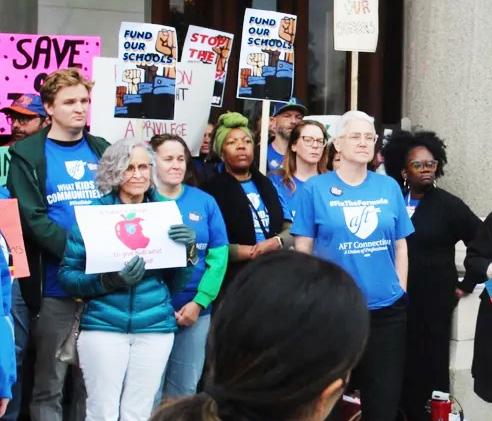






Lucy Gellman, Editor, The Arts Paper newhavenarts.org
When Wexler-Grant sixth grader Naomi Johnson found out that she would be going to a new school, in a new neighborhood, with a new group of kids next year, she felt unmoored, like the ground beneath her had suddenly gone soft. Then she summoned the wisdom of another little girl she’d gotten to know: an orphan named Annie, whose bravery made her feel like everything would be okay.
That the sun was, in fact, gonna come out tomorrow.
Naomi, who attends Wexler-Grant Community School, talked through those feelings Saturday, just minutes before the curtain opened on her starring role in Annie, Jr. A nearly lifelong member of Wexler’s music community, she’s using the musical’s life lessons to help her get through the next year, as the city’s public school district plans to merge Wexler-Grant with Lincoln-Bassett Community School. The merged school will be a PreK-8th grade school based out of Bassett’s building in Newhallville.
The district confirmed the decision in March. Only afterwards did it reach out to parents, many of whom shared deep concerns that the merger would disrupt learning and be dangerous for their children. In the months since, New Haven Public Schools Superintendent Madeline Negrón has also announced that 29 arts positions may be on the chopping block, in attempts to bridge a $16.5 million shortfall in the district's budget.
“It’s a lot, but I can handle it,” Naomi said. “I like how she [Annie] is, like, brave, and she is intelligent, like [when she spells out] M-i-s-s-i-s-s-i-pp-i. She teaches me how you gotta stand up for yourself and always believe no matter what.”
For Naomi, musical theater has been that anchor for years, but maybe never as critically as now. When she started kindergarten classes at Wexler, she had already fallen in love with music, and teacher Jaminda Blackmon was there as a safe haven. Within months, then years, Blackmon became the person who made school into a second home.
If Naomi was feeling stressed—maybe about a mistake in math, or maybe another kid who wasn’t so nice—she knew that her music classes would ease her mind (“I have a lot of anxiety,” she said matter-of-factly before the show). So when there was the chance to join the school play several years ago, it was a no-brainer. Blackmon, who has built a theater program on a shoestring budget for eight years, welcomed her with open arms.
Since then, “I’ve been in five shows,” including a Moana that went on even after a squirrel got backstage (Naomi played Tamatoa, who is a glitzy, enormous crab). Through those plays, musi-



initially expected. By last year, Mouzon had watched her daughter bloom into a person who could wrangle her anxiety one moment, and walk into a youth improv class fearless the next. When the two went to Into The Woods at Cooperative Arts & Humanities School earlier this year, they left thinking about the next big role Naomi hopes to land: a spot in their 2027 freshman class.
When she landed the starring role in Annie, the two ran lines together after school, until Mouzon knew the play almost as well as her daughter. Like Naomi, she now has a soft spot for the story, in which a young orphan belts her way through isolation and loss, wins the heart of billionaire Oliver Warbucks (Abel Anderson), outsmarts the shrewd Rooster Hannigan and Lily St. Regis (Carter Howard and Skylah Smith) and inspires a radical redistribution of wealth by the end of the second act.
cal theater has become a kind of roadmap, teaching her how to move through a challenge by running it backwards and forwards, to share space, to speak up and maintain her focus.
So when she learned about the merger with Lincoln-Bassett earlier this year, “I was a little upset, because they didn’t give parents a decision,” she said. She didn’t know if Blackmon would make the transfer with students (that fate ultimately rests with the Board of Education). She felt scared, because it was a future full of unknowns.
Blackmon with students backstage before the show. “The kids worked really, really hard. So many of them have grown, and I have seen their progress in many ways," she said.
But then she turned to the character she was just getting to know through rehearsals. Annie was brave and gritty, not afraid to dive into adventure (literally: she covers herself in dirty laundry at the beginning of the show). She was sharp and funny, with a big heart and belt-worthy vocals. She could spell Mississippi without prompting. She was a peacekeeper, breaking up fights among the girls with whom she’d built community at the orphanage.
“It’s a big change, a different environment,” Naomi said. “But once I did the show, I realized that there are so many good people here.” Many of them will be transferring with her to Lincoln-Bassett, which feels like a relief in a year upturned by confusion from the district.
For her mom, Pamela Mouzon, the change she’s seen in her daughter through arts education has been transformative. Naomi’s pull toward the stage was never in question. “She wakes up dancing and singing,” Mouzon said with a laugh. That’s been true since Naomi was tiny, and it’s true each Sunday, when she brings her skills to praise and worship in church.
But it was theater that helped her build a sense of confidence that neither of them
Mouzon also fell in love with Blackmon, whose scrappy-but-strong theater program runs on popcorn sales, elbow grease and hundreds of hours of volunteer labor from teachers and parents. Saturday, she did some of the choreography from the front row, crying by the end of the first act.
“She’s been a mentor, a friend and a teacher who has helped with her [Naomi’s] confidence and her school work,” Mouzon said. Behind her, a whole entourage had shown up to support Naomi, from Mouzon’s middle school friends to members of her church family. Two bouquets of roses, one touched up with purple glitter, waited patiently for their star beside Mouzon’s side. “She’s just awesome with the kids. ”
“It’s amazing,” chimed in Yolanda Padilla, whose daughter Destiny Cabral played Tessie, from a few seats down the row. Outside, Destiny’s dad, Meron Cabral, did candy sales and fielded t-shirt requests from proud parents. “Ms. Blackmon is a beautiful person.”
“My daughter has learned so much,” Padilla added. When her family made the move from Bridgeport two years ago, her daughter was still struggling in school. As soon as she started taking classes with Blackmon, her grades went up. Her focus improved. She was more disciplined, both in and out of class. Next year, Padilla said, she’s transferring to Lincoln-Bassett because Blackmon is, too.
Saturday, that was on full display for so many of the students, as the curtains opened to a 1930s-era New York City orphanage. Beneath gem-colored green and red lighting, actors sprang from their beds, watching Annie break up a girl fight. As she turned to leave, an imperious Miss Hannagan (Jayla Buford) made her entrance, fuming in a cheetah-print robe and gold silk bonnet. Within seconds, cast members had jumped into “It’s A Hard Knock Life,” holding mops
by Maya McFadden
Amin Sapand wants to go back to biking as his primary mode of transportation like it was when he was living in Afghanistan. Earlier this week, the Adult Education student secured new bike lights to accompany his bike lock and helmet while he practiced his bike etiquette at the school’s “bike rodeo.”
Samand joined his fellow students at the New Haven Adult Education Center Monday in taking a 30-minute break from academic lessons at around 10 a.m. Students took that time to learn how to maintain and ride bikes safely as a means of daily transportation.
The bike rodeo was part of Adult Ed’s multicultural festival running from May 12 to May 23. The festival is being hosted by Adult Ed’s Project Museum program. Monday’s event was in partnership with New Haven Coalition for Active Transportation (NCAT) and The Devil’s Gear Bike Shop. It also took place during New Haven Bike Month.
Event organizers taught Adult Ed’s diverse student body about New Haven’s e bike-share program and local spots like Devil’s Gear for bike maintenance. Devil’s Gear, on Chapel Street downtown, helps maintain not only New Haveners’ regular bikes but also the city’s rent-bythe-ride e bikes.
Adult Ed Student Support Specialist Michael Twitty said biking for students can be a hobby, a form of exercise, or an affordable transportation option.
NCAT Education Director and instructor Elias Estabrook said Monday’s partnership was possible thanks to recent grants to improve the city’s bike-share program.
Monday’s first group of students, part of the English for Speakers of Other Languages (ESOL) Program, joined the bike rodeo in the parking lot of 580 Ella T Grasso Blvd. They first signed a safety waiver, then they learned some bike basics from the Devil’s Gear team.
Devil’s Gear owner John Brehon reminded the students to at least quickly check on their bike everyday, especially before they begin to ride. He broke this down through the “bike ABCs,” which stand for the three most important things to check your bike for before getting on the road: air, brakes, chain.
First check your tires’ air, then the brakes, then the chain, aka your bike’s transmission, he said.
Next the students borrowed helmets, and learned how to find the best-fitting one. First, they learned how to ride an e bike.
They learned how to adjust their bike seats. Students practiced riding on a cone course constructed by the event’s partners.
Twitty reminded them to hold the brake firm and to not pedal while making turns, otherwise the bike would speed up.



Another demonstration tasked students with riding a conventional bike and racing each other with a twist. The race winners were not the fastest bikers but instead the slowest.
The first winners of Monday’s snail races were ESOL students Amin Sapand and Moondy Dumond. They were each awarded a bicycle headlight and a taillight.
Monday was Dumond’s first time riding a bike. Sapand, meanwhile, recalled riding bikes in Afghanistan before immigrating to New Haven less than a year ago. He said Monday’s lessons were easy and motivated him to soon secure his own bike. With his new bike lights, and a helmet and a bike lock he previously received, all he has left to get is a bike of his own.
He said getting a bike will help him get to and from his Adult Ed program easier, and it’s a clean mode of transportation, which he likes.
In another lesson, Twitty helped two high school-credit students, Gary Scott and Isaiah Hampton, practice “scanning” which he said will help them be more aware of their surroundings on the road, particularly when making turns at congested intersections.
As they each rode on a conventional bike, Twitty stood at a distance as the students rode through the practice course. He then would randomly hold up his arm and display the number 1, 2, 3, or 4 with his fingers. Scott and Hampton had to practice looking over their left shoulder to see which number Twitty held up and then call it out loud.
“A good way to turn is tuck chin into shoulders,” Twitty advised.
High school-credit students Tunai and Abigail also took a break from class Monday to learn the “professional way” to ride a bike, as opposed to the “street way,” they said.
Tunai, who is a senior, said she was able to learn something new: the ABCs she learned from Brehon before getting on the bike.
They both agreed they prefer the conventional bikes over the e bikes.
“They’re too fast,” Tunai said.
They both are on track to graduate in November of this year. They also agreed that Adult Education is a better academic setting for them than their previous high schools because there are less people, the staff are more supportive, and they earn learning breaks throughout the day.
“Biking is becoming a better option to get to and from work, to and from school, and at an affordable rate,” Twitty said. “We want to instill in them the proper way to use a bicycle and the safest way to navigate city streets.”
It also makes it so that no students have an excuse to not come to school when they have no ride or bus fare, Twitty added.

John P. Thomas Publisher / CEO
Babz Rawls Ivy Editor-in-Chief Liaison, Corporate Affairs Babz@penfieldcomm.com
Advertising/Sales Team
Keith Jackson Delores Alleyne
John Thomas, III
Editorial Team
Staff Writers
Christian Lewis/Current Affairs
Anthony Scott/Sports Arlene Davis-Rudd/Politics
David Asbery / Tanisha Asbery
Jerry Craft / Cartoons / Barbara Fair Dr. Tamiko Jackson-McArthur
Michelle Turner / Smita Shrestha William Spivey / Kam Williams Rev. Samuel T. Ross-Lee
Contributors At-Large
Christine Stuart
www.CTNewsJunkie.com Paul Bass www.newhavenindependent.org
National Association of Black Journalist
National Newspapers Publishers Association
Greater New Haven Chamber of Commerce
Greater New Haven Business & Professional Greater New England Minority Supplier Development Council, Inc.
The Inner-City Newspaper is published weekly by Penfield Communications, Inc. from offices located at 50 Fitch Street, 2nd Floor, New Haven, CT 06515. 203-3870354 phone; 203-387-2684 fax. Subscriptions:$260 per year (does not include sales tax for the in State subscriptions). Send name, address, zip code with payment. Postmaster, send address changes to 50 Fitch Street, New Haven, CT 06515. Display ad deadline Friday prior to insertion date at 5:00pm Advertisers are responsible for checking ads for error in publication. Penfield Communications, Inc d.b.a., “The Inner-City Newspaper” , shall not be liable for failure to publish an ad or for typographical errors or errors in publication, except to the extent of the cost of the space in which actual error appeared in the first insertion. The Publisher reserves the right to refuse advertising for any reason and to alter advertising copy or graphics deemed unacceptable for publication. The entire contents of The Inner-City Newspaper are copyright 2012, Penfield Communications, Inc. and no portion may be reproduced by any means without the written permission of the publisher. 10
by Jisu Sheen
Lisseth Martinez needed a pop of springtime bliss for their table at Spruce Coffee’s Crafters of Color fair on Sunday. They called upon trusty co-worker Sarah at Whitney Avenue bagel shop Olmo to find something magical at the Wooster Square farmer’s market, where Olmo regularly sets up shop on the weekends.
Sarah delivered, bringing back an array of hefty unbloomed peonies. As the Sunday sun warmed Spruce’s sidewalk, pink petals blossomed over Lisseth Martinez’s Lissedibles, cute clay creations with boobs, butts, queer terminology, and Bad Bunny fan designs. The flowers added a touch of ethereal grace to the small outdoor stove Martinez was using as a display shelf for food-themed ceramic magnets.
Martinez had successfully participated in a longstanding New Haven artist tradition: making your day job work for you.
The Crafters of Color, a group of local New Haven area artisans of color vending together at New Haven artsy digs like Witch Bitch Thrift, Koffee?, Bradley Street Bike Co-op, and of course Spruce, filled the cozy coffeeshop Sunday and spilled out onto its State Street sidewalk. Visitors could grab a Jasmine Matcha or Rosie Palmer (think Arnold Palmer but rose-themed, with a hint of mint) and wander through nine decked-out tables of specialty crafts.
Zoē Pringle, selling her wares as Pringle Painting Plus, had a gumball-machine-like contraption among the astrological paintings and ceramics at her table. Customers could pay $5, take a spin, and collect a random assortment of not candy, but perhaps the candy of the craft world, beads.
I caught up with Ericka Saracho, who runs ceramics shop Bright Raven Studio with Gabriela Margarita De Jesus, just as they were selling a “berry bowl” to Damali Willingham. The bowl, as Saracho and Willingham told me excitedly, had holes in the bottom to wash and drain fruits. “You can eat the berries right out of it!” Willingham explained, ready to take this upcoming summer to the next level.
The berry bowl wasn’t the only beautiful oddity on Bright Raven’s table. Saracho also showed off an arrangement of so-called “mommy pots,” super tiny vases perfect for holding just one stem that a small child might bring you; “Mommy, look!”
For larger bundles, like the peonies Martinez scored from their co-worker, even a regular-sized artisanal vase might not be enough. Martinez ended up splitting their flower stash with friend and Wet Clay Works studiomate Tirza Harris, vending at the table right beside them.
“People call me the butterfly girl,” Harris said, a reference to all the clay butterflies she makes. One of the winged creatures, with multidimensional iridescent


loops, stood watch as kids, adults, and dogs flitted in and out of the coffeeshop.
I asked about a boxy vase with a gorgeous glaze, and Harris wrapped it lovingly in her hands, explaining it wasn’t for sale. It was part of an art trade between Harris and Pringle, one of many I could spot throughout the afternoon.
As the day wore on, the vendors’ tables








melted into a cohesive art piece, with artists sharing, trading, and proudly displaying each others’ work.
The Crafters of Color embodied friendship, curiosity, and mini-adventures Sunday afternoon. Martinez, delighted with their flowers, put it simply:
“You never know unless you ask.”













Abiba Biao, The ArtsPaper newhavenarts.org
“All power to the people!” Ann Boyd said, raising a first in the air.
Within seconds, dozens of fists joined had hers, cementing solidarity and community empowerment. “All power to the people!” members of the crowd shouted back.
Boyd—who has for decades held it down as a community matriarch— was one of three New Haveners honored last Saturday at “Honoring Hill Legends: Moving On Up,” a project of the International Festival of Arts & Ideas and a dedicated Hill neighborhood committee that is several years running. Held in Trowbridge Square Park, the celebration fêted both longtime Hill activists and the Hill itself, which remains the largest and most diverse neighborhood in the city.
The festival continues Arts & Ideas’ celebration of New Haven neighborhoods, which began this month with fests in Fair Haven and Whalley/Edgewood/Beaver Hills. Alongside Boyd, the day also honored Hill stalwart John (Johnny) Dye, who passed away last year at 84, the late hip-hop icon Lee Stucky, and veterans of the Vietnam War.
“The Hill is very intentional about showing love to the Hill.” said Shamain McAllister, associate director of education and community impact for Arts and Ideas. “There’s so much history in where we stand. You know, people want a key to the city, but folks got a key to the Hill that’s from their people, by their people, towards those who have served here.”
For lifelong Hill residents like Dr. Pamela Monk Kelley, a member of the festival planning committee and co-chair of

the Hill North Community Management Team, it was a chance to honor the long history of the neighborhood, and the people who have lent it a steady heartbeat. Kelley, one of eight siblings who grew up on Cedar Street, has spent her life advocating for the neighborhood.
“I was born in the Hill, I was raised in the Hill with a school in the Hill, and I also serve God in the Hill,” Kelley said. “So it is very important for me to give thanks, and this day is another way of giving back, bringing together something positive.”
Sitting beside her, her brother Conley F. Monk Jr. ran the commemorations for veterans, distributing legal resources that have become even more critical amongst recent cuts to Veterans Affairs (VA). A Vietnam veteran himself, Monk Jr. founded the National Veterans Council for Legal Redress to provide legal resources to veterans.
“We was never honored when we came back from Vietnam,” he said. “They need to know that there's services available for them, and that's how we help them.”
But the day’s highest praise belonged to Boyd, who came out surrounded by several generations of family and friends in the neighborhood she calls home. Born in Ridgeville, South Carolina, Boyd has lived a life of activism, juggling a dedication to justice work with her love for a big, generations-deep family of New Haveners.
After moving to the Hill as a kid in the 1950s, she has spent her life making the neighborhood a kinder and more just place for those who call it home, from members of the Black Panthers in the 1970s (read more about that here and
here) to groups like the Columbus West Tenant Association and Project MORE. Along the way, she raised eight children, working to defend their rights and the rights of other young people as a leader of the Hill Parents Association (HPA).
One year after HPA Founder Fred Harris received his flowers at the same festival, it was only right that she did, too. Her family added that they are grateful: Boyd received a medical diagnosis in March that she only had a few months left to live. Unlike Dye, who was awarded his honor posthumously, she’s here to see it.
It’s clear, too, that she leaves a legacy of justice in the Hill: Boyd’s vigor and grit is palpable through her family and friends. Her granddaughter Tiana Cornelius, a first-year sports management major at Albertus Magnus College, spoke about how she was inspired to write about her grandmother for a class assignment. When she received the prompt to write an essay about an activist, there was no better person she could imagine.
“You could have a feeling of giving up and just going to speak with my grandmother for a little bit of time just made me feel like ‘If she did it, why can't I do it?’” Cornelius said.
“This is the biggest moment for me, and I can say that because in March, we just got a phone call from her doctor saying that she wasn't gonna be able to make it,” she added, calling the festival a “beautiful moment.”
“God's blessing, she's still with us and able to come to this event to honor her with the key to the Hill, to represent and dedicate her moments in time that she's done for the community and what she's done for people in the community.”
by Donald Eng
HARTFORD, CT — Capitol police arrested 10 education advocates Wednesday following a rally and staged sit-in outside Gov. Ned Lamont’s Capitol office.
The event had begun just after 4 p.m. with several hundred supporters rallying outside the Capitol. The group’s demands included fully funding schools in the state’s poorest districts, adding a 50% weight to the funding formula for special education students, strengthening the Trust Act, and passing legislation making striking workers eligible for unemployment benefits after 14 days, according to New Haven Federation of Teachers President Leslie Blatteau.
“Students who need the most have the least,” said Julia Miller, Connecticut’s 2025 Teacher of the Year.
Miller said 129 student-facing positions were facing elimination in New Haven as a result of budget limitations. She pointed out that the state is currently running a budget surplus and has a multi-billion dollar fund balance.
“What are we waiting for?” she said. “The funds are there.”
Following the outdoor rally, the group, consisting of American Federation of Teachers (AFT) Connecticut and the New Haven Federation of Teachers, entered the Capitol and requested a meeting with Lamont.
After a 20-minute closed-door meeting that included about 25 protesters, the group emerged and Blatteau announced to the crowd that Lamont had not committed to meeting the group’s terms.
“We acknowledge there has been progress,” she said. “And today, the

House passed revisions to the Trust Act.”
Lamont’s office later released a written statement.
“Governor Lamont invited members from AFT to his office today to hear their thoughts and concerns,” according to the statement. “Connecticut has the best schools in the country because we have the best teachers in the country. That’s why he has made historic investments and increases in education funding. During the final weeks of session, he plans to work with the legislature that continues that progress.”
But with the lack of a firm commitment on funding, Blatteau sat down at the center of a line of 10 advocates across the entrance to the governor’s office suite.
Capitol police warned the group to leave or face arrest, to which Blatteau replied, “We’re staying for the children.”
as they synchronized their choreography and belted the hook.
Blackmon, who had been backstage with the actors moments earlier, buzzed around the auditorium, checking in occasionally with Kevin James (in addition to Wexler-Grant’s band director, he has become a musical theater staple in the city’s schools, from Co-Op to New Haven Academy) and Ms. Lynn. At one point, she looked over and smiled at Ulesha Howard, the mom of three actors who had jumped onboard to help.
“She’s like the heartbeat of this school,” Howard had said of Blackmon earlier in the day, as she called places from backstage. “I can’t do it [as a parent] without the art program. I need the music.”
Back onstage, students made the play their own, mining the script for a surprising amount of feeling that is baked into the show. Orphans pulled out choreography that seemed beyond their years, including a kickline in which no one miraculously missed a step. Warbucks, played by a thoughtful Abel, knew exactly where to pause and where to speed up, finding the humor in lines like “Smell those bus fumes!” and “Come on you slowpokes, we gotta get to the Roxy before the prices change!”
Grace, a winsome Brielle Watley, landed her lines, channeling some big mom energy in a play all about orphans. Ensemble members scurried and hopped, finding their way into the choreography just when it seemed that the stage couldn’t hold another person. Even Jaylah, Carter and Skylah embraced their villainous roles with wit and panache, wheeling and dealing as if they had watched The Godfather for inspiration. But the play belonged to Naomi, whose vocals left no doubt that she would be ready for bigger, brighter stages in the months and years to come. As she wished upon a locket, hid herself in the laundry, sashayed through Warbucks’ home, dazzling in her signature red dress, she became both songbird and storyteller, turning the musical into a reminder that it is worth holding onto—and seeking out—the sunny days ahead.
“It felt good!” she said afterwards, as she posed for photos with a ring light. “I liked how we all worked together. We all got through everything.”
That sentiment rang true for Blackmon, who had been at school since that morning to provide a celebratory waffle breakfast for the cast. Ten years ago, she started an after-school theater program at Lincoln-Bassett, during her first years in the district.
Then eight years ago, she brought that work to Wexler-Grant. In the midst of a wild year, it’s given her a clear goal to hold onto.
“It was great," she said. “The kids worked really, really hard. So many of them have grown, and I have seen their progress in many ways."

by Maya McFadden
As Wexler-Grant fourth grader Destiny Cabral walked across Hillhouse’s stage to receive an award for her growth in reading this year, her dad Meron Cabral cheered her on just a few feet away until he was called up on stage right after her for the surprise announcement that he had been recognized as Parent of the Year.
The father-daughter Cabral duo were two of the hundreds of students, staff, and parents recognized Wednesday at New Haven’s 45th annual Florence Caldwell Academic Achievement Awards Ceremony.
This year the celebration filled Hillhouse High School’s auditorium for several hours as elementary school students were recognized for growth in subjects like math and reading.
School leaders and staff presented students with their recognition certificates alongside New Haven Public Schools (NHPS) Supt. Madeline Negrón, Board of Education member Andrea Downer, and NHPS Chief Financial Officer Linda Hannans, who took turns placing winning medals around each student’s neck.
The first-through-fifth graders were also each gifted a McDonald’s meal voucher.
The awardees were from a wide range of city schools, including Barack Obama, King Robinson, Lincoln Bassett, Nathan Hale, Wexler Grant, Conte, East Rock, FAME, Ross Woodward, Barnard, Bishop Woods, Clinton, Clemente, Fair Haven,

Edgewood, Hill Central, Troup, and Truman.
An hour into Wednesday’s ceremony, Wexler-Grant fourth grader Destiny Cabral took the stage to accept her reading improvement award. She did not exit after
YOUR REGIONAL NON-PROFIT CENTER FOR THE PERFORMING ARTS, FILM & EDUCATION

receiving her medal and gifts like others, however, and instead was surprised with the opportunity to give the next person their award.
That next award winner turned out to be Meron Cabral, Destiny’s father, who was
already right up front and video-recording his daughter receiving her award, just as he did the year before for his daughter Janessa, who attends Clinton Avenue School.
Destiny said Wednesday that while she doesn’t really enjoy reading, she’s happy
she’s improving. She also said her father deserved Wednesday’s parent recognition award because he motivates her everyday to keep trying hard to improve in subjects like reading.
Meron Cabral is not a new face to the district-wide parent advisory council (DWPAC), which hosts the annual ceremony and is chaired by Florence Caldwell.
“It’s important when you get a dad because moms are always there,” a Wexler staffer told the audience of hundreds while presenting Meron Cabral with a Parent of the Year plaque.
Even before moving to New Haven two years ago, Cabral has been very active with parent advisory councils, as he was involved when his daughters were enrolled in Bridgeport’s public school district.
Cabral was surprised to hear his name called. He excitedly accepted his award Wednesday alongside his daughter. His said he hopes the recognition inspires other fathers to be more active in their kids’ schooling, as he’s seen his constant support for his daughters help develop their confidence and desire to learn.
Cabral also recalled growing up with parents who had to work two, three jobs and therefore couldn’t make it to his award ceremonies as a child. While he understood why, he has vowed to live up to a promise to himself that he will “always be there for mine, no matter what.”
He hopes his participation in his kids’
Con’t on page 10

FRIDAY | 06.06.25 8:00 PM







FRIDAY | 06.06.25 8:00 PM
by Addie Davis-Wardlaw
This following writeup was submitted by
Addie Davis-Wardlaw.
My daughter, Laura Dixon, and my college roommate and best friend’s daughter, LaShante’ James, both received the Connecticut Association of Schools (CAS) 2025 Assistant Principal of the Year award for their respective school levels. Laura received the elementary award for her exceptional work at John Barry Elementary School in Meriden, and LaShante’ was honored with the high school award for her dedication at Brien McMahon High School in Norwalk.
My friend, Dr. Pamela Monk-Kelley (LaShante’s mother), and I, Addie Davis-Wardlaw, first met at Southern Connecticut State University in 1973 while attending their summer program designed to acclimate minority students to college life. There, our friendship began.
Pamela was from New Haven, an inner city, compared to Colchester, where I was raised in a more suburban environment. I was intrigued by Pamela because she was a young mother to LaTrisha Tucker who later also became an honored teacher for Monarch Elementary School in Union, S.C., in December 2022 (Teacher of the Year) and May 2023 (District Teacher of the Year). Her ability to juggle her studies and motherhood and still live life made me appreciate her and her drive even more.
While at SCSU, I accompanied Pamela and her family to their hometown in North Carolina. Even though my parents were from the South, up until this point, I had never traveled beyond New York. I visited some of Pamela’s family homes that had outhouses and in-houses; I was confused and later called and questioned my father in disbelief that homes without proper plumbing still existed. He laughed and realized, with 15 siblings and me being the middle child, that he had never traveled with me whenever he returned home to Atlanta, Ga. My exposure and interactions with Pamela truly made me open my eyes and become a better person.
We celebrated many milestones, including when she married her high school sweetheart and LaTrisha’s father, Larry Kelley; I was honored to be one of her bridesmaids. Her family truly became my extended family. Her mother babysat my firstborn, Estelle Jeter. My kids took part in fashion shows and talent shows that Pamela or her sister Marcella Flake had organized. When reunions or gatherings were organized that involved alum-


ni of our summer program or SCSU, we usually took part in the planning. When unexpected grief hit us, especially when I lost my father, my rock, Pamela and her sisters were there for me and my family. When Pamela suffered the unimaginable loss of her only son, Larry Jr., who succumbed to his death because of a car accident, I, along with her strong network of family and friends, were there in solidarity.
Anyone who knows Pamela knows she has a strong faith in God and in the power of prayer. She also received her doctoral degree in Theology. We both graduated from SCSU with Bachelor of Science degrees in special education. I went on to teach Special Education for the Connecticut Department of Correction (DOC), and Pamela (or, Dr. Monk-Kelley), without hesitation, joined me for a summer
school that Pamela and I received our degrees from. They both began their teaching careers in the same system that taught and inspired them, New Haven Public Schools. Both are married with children between the ages of 6 and 13, and they are both strong individuals deeply committed to children, dedicated to achieving positive outcomes and fostering growth. These young women, despite their professional success, also navigate significant personal challenges. Laura was surprisingly diagnosed with breast cancer in 2024 at the age of 38, and LaShante’s husband was unexpectedly left paralyzed after botched heart surgery in 2023. Yet, they continue to excel in their demanding roles, driven by their passion for their work, their love for their families, and their faith in God.
of teaching there. She then dedicated her career to teaching special education students for the New Haven Public Schools, serving in numerous roles, including director for plays, choirs, cheerleader coach, and coordinator and chairperson for Planning and Placement Team (PPT) meetings.
After my retirement from the DOC, I also joined the New Haven Public Schools as a special education teacher, and within three years, like Pamela, I became a coordinator, assisting the principal with day-to-day activities.
Throughout the years, our bond remained strong. In 2021, when I returned to work and began working at Highville Charter School, I asked Pamela to join me as a consultant, and she did, because we love brainstorming and working together.
When our daughters received this prestigious award, we immediately called each other. We were initially surprised, then overjoyed, to learn that our daughters had both received such a significant honor from two different districts, yet their paths were cultivated from the same roots.
What’s particularly incredible about these two accomplished young women is that they both attended and graduated from New Haven Public Schools. They furthered their education by receiving scholarships and graduating with honors with their bachelor’s, master’s, and 092 administrative degrees in Education. Notably, one of the universities they attended and received degrees from was SCSU, the same
schools grows their confidence and shows them they have a strong support system around them.
He added that school-related parent involvement shouldn’t continue to fall only on mothers. “It’s important to have both moms and dads, especially dads, because they haven’t been stepping up for so long,” he said.
He concluded that Wednesday’s recognition serves as a reminder to him to continue the work he’s been doing to get on a more positive path forward. Cabral hopes to also be recognized for the good he’s been doing on June 2 when he expects to hear back about the results for a state pardon he recently applied for.
“I just learned I’m going to be a grandfather. My baby got her award tonight and I’m being seen by my community for the good I’m doing. When I hear back for my pardon, June 2, I’ll really be able to show how far I’ve come,” he said.
Destiny and Janessa’s mom, Yolanda Padilla, was the only one that knew in advance that Cabral would be surprised with an award Wednesday. She made sure to keep the secret to herself. It wasn’t hard to get the plan in motion because all she had to do was tell Cabral that Destiny was getting an award and he said he would attend the ceremony.
“He’s been so supportive since day one,” Padilla said. “Everything with their school, he’s involved.”
She said she’s seen their daughters, who have autism and ADHD, improve academically because they know both of their parents regularly check in with the school. “He deserves this. He’ll drop anything when it comes to the kids,” Padilla concluded. “It makes him feel so good to help out and he does a lot. He loves his community and has been setting a good example for other male figures.” Con’t



by Mona Mahadevan
HARTFORD Ten public education advocates, including five New Haven teachers and one student, were arrested at the state Capitol Wednesday afternoon during a sit-in outside Gov. Ned Lamont’s office.
The arrests capped off a spirited protest at the center of state government, where over 200 teachers and students gathered to demand more state funding for Connecticut’s public schools.
Chief among their demands: raising the Education Cost Sharing (ECS) foundation amount and adopting a higher weight in the ECS formula for students with special needs.
The demonstration organized by the New Haven Federation of Teachers, AFT Connecticut, and Connecticut For All took place as New Haven Public Schools Supt. Madeline Negrón considers laying off 129 employees, including 56 teachers and all 25 librarians, to close an anticipated budget shortfall of $16.5 million for the 2025 – 2026 school year. With the June 4 deadline for the state’s biennial budget approaching, education and labor advocates across Connecticut have ramped up their calls for more school funding.
Wednesday’s outing marked just the latest trip to Hartford by New Haveners who have visited the Capitol time and again this legislative session to press state government to come through with more funding for public education.
Included among those arrested as part of Wednesday’s act of civil disobedience were New Haven teachers union President Leslie Blatteau and Wilbur Cross student John Carlos Serana Musser, a student representative on New Haven’s Board of Education.
On Wednesday at 3 p.m. sharp, 30 New Haven Federation of Teachers members rode a yellow school bus from the teachers union headquarters on Chapel Street to Hartford. Clad in bright blue t shirts, they passed around Goldfish, gummies, and protest signs made by their students. Garrett Frye-Mason and Dave Weinreb, teachers at Elm City Montessori, said that in addition to specific changes in the ECS formula, they want the process of funding schools to be more democratic. “Teachers, districts, and local communities should have more control over the purse strings,” Frye-Mason said.
On a seat across the aisle, Hillhouse High School teacher John Saksa scrolled through photos on his phone showing ceiling tiles mottled with mold and classroom floors filled with holes. He said he had learned that two English teachers at his school would be laid off if Negrón’s plan is implemented, which might lead to class sizes of 30 or more students, even though the NHFT’s contract states that class sizes can’t exceed 27.
After deboarding the bus, High School in the Community teacher Ben Scudder launched the protest’s opening chant: “When public education is under attack,


what do we do?” In unison, the growing crowd responded, “Stand up! Fight back!”
Despite the chilly drizzle, public school teachers and students stood outside the Capitol to speak about their experiences with Connecticut schools. “We’re fighting for something that I don’t think we should have to fight for,” said Metropolitan Business Academy civics teacher Julia Miller, who last year was named Connecticut Teacher of the Year. She noted that while boards of education need to be responsible stewards of educational funds, districts across the state face vastly different circumstances. “Let’s be real,” she said. “In our tale of two Connecticuts, there are districts that have never faced this choice.”
Around 4:30 p.m., 25 demonstrators entered a closed-door meeting with Gov.


Lamont. According to Metropolitan Business Academy teacher Izzi Geller, the governor took careful notes and asked questions, including about “how students are doing after the pandemic.” But when pushed to amend the ECS formula, he explained that the budget could not accommodate both a significant increase in school funding and full support for teacher pensions. He also emphasized that Connecticut’s public schools are among the best in the country.
Twenty minutes later, NHFT President Leslie Blatteau emerged to announce that ten demonstrators five New Haven teachers and one student, one New Britain teacher, and three Connecticut for All members would continue sitting outside of the governor’s office in protest. Within minutes, they were arrested on charges of disorderly conduct.
As an officer zip-tied one woman’s hands, the arrestee told bystanders, “Today is my son’s 21st birthday, but I am choosing to be here because this is more important.”
The protest followed a formal letter from AFT Connecticut to Gov. Lamont, calling for an increase in the ECS foundation amount from $11,525 to $12,488 a recommendation made in the 119K Commission’s Young People First report and the adoption of a 50 percent weight for students with disabilities.
“Now is the time for us to commit to the promise of public education for our current and future students,” that letter reads in part. “In one of the richest states in the richest country in the history of the world, we must deliver the education our students deserve.”
In a statement responding to the letter, Lamont’s press secretary David Bednarz said, “Connecticut has the best schools in the country because we have the best teachers in the country. That’s why [the governor] has made historic investments and increases in education funding. During the final weeks of session, he plans to work with the legislature to continue that progress.”
Lamont reiterated those points during the in-person meeting a response that some protesters described as out of touch. “There are two Connecticuts,” Blatteau said.
“Governor Lamont does not see the reality of working-class, low-income, Black, and brown families in Connecticut.” Geller echoed her sentiment, noting that students in cities like New Haven, Hartford, and New Britain have been shortchanged compared to those in wealthier districts.
Though the governor did not accede to their demands, the demonstrators were glad to have spoken up about their concerns with political leaders across the state. As they left, boarding the bus back for New Haven at around 6 p.m., they chanted, “We’ll be back.”
NHFT members and allies get off the bus and begin walking to the front of the Capitol.





• Cremation (Choose to be cremated at Evergreen.)
• Columbarium in the Most Beautiful Cremation Garden
• Reserve your Niche in a secure location pre-need.

• Reserve a Niche for family and friends or purchase at-need to safely place your Loved One in the Columbarium.
• Burial Lots (infant, single, two-grave, or four-grave)
• Monuments & Markers (black, gray, or pink granite)
• Flower placement (single or multiple placement)
• All orders can be placed at the Evergreen office or the website.

By April Ryan
“The president's been very clear he has no intentions of pardoning Derek Chauvin, and it's not a request that we're looking at,” confirms a senior staffer at the Trump White House. That White House response results from public hope, including from a close Trump ally, Georgia Congresswoman Marjorie Taylor Greene. The timing of Greene's hopes coincides with the Justice Department's recent decision to end oversight of local police accused of abuse. It also falls on the fifth anniversary of the police-involved death of George Floyd on May 25th. The death sparked national and worldwide outrage and became a transitional moment politically and culturally, although the outcry for laws on police accountability failed.
The death forced then-Democratic presidential candidate Joe Biden to focus on deadly police force and accountability. His efforts while president to pass

the George Floyd Justice in policing act failed. The death of George Floyd also put a spotlight on the Black community, forcing then-candidate Biden to choose a Black woman running mate. Kamala Harris ultimately became vice president of the United States alongside Joe Biden. Minnesota State Attorney General Keith Ellison prosecuted the cases against the officers involved in the death of Floyd. He remembers,” Trump was in office when George Floyd was killed, and I would blame Trump for creating a negative environment for police-community relations. Remember, it was him who said when the looting starts, the shooting starts, it was him who got rid of all the consent decrees that were in place by the Obama administration.”
In 2025, Police-involved civilian deaths are up by “about 100 to about 11 hundred,” according to Ellison. Ellison acknowledges that the Floyd case five years ago involved a situation in which due process was denied, and five years
later, the president is currently dismissing “due process. “The Minnesota Atty General also says, “Trump is trying to attack constitutional rule, attacking congressional authority and judicial decision-making.” George Floyd was an African-American man killed by police who knocked on his neck and on his back, preventing him from breathing. During those minutes on the ground, Floyd cried out for his late mother several times. Police subdued Floyd for an alleged counterfeit $20 bill. :
Mural showing the portrait of George Floyd in Mauerpark in Berlin. To the left of the portrait the lettering "I can't Breathe" was added, on the right side the three hashtags #GeorgeFloyd, #Icantbreathe and #Sayhisname. The mural was completed by Eme Street Art (facebook name) / Eme Free Thinker (signature) on 29 May 2020. (Wikimedia Commons)
by Dollita Okine, Face2FaceAfrica.com
Gianna, George Floyd’s 11-year-old daughter, and her family members disclosed the heartbreaking truth of the bullying she has experienced at home in Texas five years after Floyd was killed by Minneapolis police.
Gianna went viral in 2020 when, at the age of six, she sat on the shoulders of her father’s close friend, former NBA great Stephen Jackson, and
exclaimed to the audience, “Daddy changed the world!”
According to her relatives, Gianna has been a victim of school bullies who harass her by bringing up “the nasty things” people say about her father.
“They’ve teased her at school,” a column in the Minnesota Star-Tribune read. “They know about her father and the nasty things bad people say about him, so they repeat those words.”
When asked how life was without

her father, Gianna acknowledged that “It’s hard.”
After arresting Floyd on suspicion of purchasing cigarettes with a fake $20 money, police officer Derek Chauvin fatally pushed his knee into Floyd’s neck for nine minutes and 29 seconds outside a convenience shop in Minneapolis on May 25, 2020.
Roxie, Gianna’s mother, admitted that she struggles with how to react, choosing between urging her daughter to fight for herself and going to the
school to get answers.
Floyd’s death provoked worldwide protests against police violence and racial inequality.
In April 2021, Chauvin was found guilty of Floyd’s murder and given a sentence of over 22 years in prison. Meanwhile, critics and commentators have repeatedly used Floyd’s personal history – his previous addiction, criminal record, and the toxicology results from his autopsy – to discredit the movement that his death sparked.
By Stacy M. Brown Black Press National Correspondent
The Southern Poverty Law Center has identified 1,371 hate and antigovernment extremist groups operating across the United States in 2024. In its latest Year in Hate & Extremism report, the SPLC reveals how these groups are embedding themselves in politics and policymaking while targeting marginalized communities through intimidation, disinformation, and violence. “Extremists at all levels of government are using cruelty, chaos, and constant attacks on communities and our democracy to make us feel powerless,” said SPLC President Margaret Huang. The report outlines how hard-right groups aggressively targeted diversity, equity, and inclusion (DEI) initiatives throughout 2024. Figures on the far right falsely framed DEI as a threat to white Amer-
icans, with some branding it a form of “white genocide.” After the collapse of Baltimore’s Francis Scott Key Bridge, a former Utah legislator blamed the incident on DEI, posting “DEI = DIE.” Tactics ranged from local policy manipulation to threats of violence. The SPLC documented bomb threats at 60 polling places in Georgia, traced to Russian email domains. Similar threats hit Jewish institutions and Planet Fitness locations after far-right social media accounts attacked them for trans-inclusive policies. Telegram, which SPLC describes as a hub for hate groups, helped extremists cross-recruit between neo-Nazi, QAnon, and white nationalist spaces. The platform’s lax moderation allowed groups like the Terrorgram Collective—designated terrorists by the U.S. State Department—to thrive. Militia movements were also reorganized, with 50 groups documented in 2024. Many, calling

themselves “minutemen,” trained in paramilitary tactics while lobbying local governments for official recognition. These groups shared personnel and ideology with
white nationalist organizations. The manosphere continued to radicalize boys and young men. The Fresh & Fit podcast, now listed as a hate group,
promoted misogyny while mocking and attacking Black women. Manosphere influencers used social media algorithms to drive youth toward male-supremacy content. Turning Point USA played a key role in pushing white nationalist rhetoric into mainstream politics. Its leader Charlie Kirk claimed native-born Americans are being replaced by immigrants, while the group advised on Project 2025 and organized Trump campaign events. “We know that these groups build their power by threatening violence, capturing political parties and government, and infesting the mainstream discourse with conspiracy theories,” said Rachel Carroll Rivas, interim director of the SPLC’s Intelligence Project. “By exposing the players, tactics, and code words of the hard right, we hope to dismantle their mythology and inspire people to fight back.”




By Stacy M. Brown Black Press National Correspondent
More than any president in modern history, Donald Trump has turned the White House into a source of personal wealth, with a scale of profiteering that experts say eclipses previous administrations— and with little political consequence. “I’ve been watching and writing about corruption for 50 years, and my head is still spinning,” said Michael Johnston, professor emeritus at Colgate University and author of several books on corruption. Investigations by multiple news outlets, including the New York Times, Bloomberg News, PBS, and Open Secrets, reveal that since returning to power, Trump and his family have significantly expanded their business empire, using the presidency as leverage to capitalize on a level of influence and impunity that has redrawn the boundaries of acceptable conduct in Washington. From cryptocurrency schemes and high-dollar memberships to foreign gifts and real estate ventures, the Trump family has raked in hundreds of millions. Since his reelection, Trump has reportedly doubled his net worth. The Trump name has driven more than $10 billion in real estate transactions and generated over $500 mil-

lion from a single cryptocurrency venture. His newly formed $TRUMP coin was launched just before taking office in January, with access to private investor dinners sold based on personal investment—not campaign contributions.
Bloomberg News reported that Trump’s ventures now span financial services, gun sales, and drone part manufacturing. His family members have secured corporate appointments, including at least seven executive roles for Donald Trump Jr. The brazenness has raised alarm among longtime observers. “By conventional Washington standards, the still-young Trump administration is a candidate for the most brazen use of government office in American history,” wrote Peter Baker of the New York Times, citing the potential to eclipse even Watergate and the Teapot Dome scandal. One of the more glaring examples occurred recently when Jeff Bezos reportedly agreed to finance a promotional film for Melania Trump following a dinner at Mar-a-Lago. The $28 million deal—280 times the amount Hillary Clinton once earned from a 1980s cattle futures investment that sparked weeks of scandal—has gone largely unnoticed in Washington.
In another instance, Qatar handed over
a luxury aircraft valued at $200 million, officially donated to the Air Force but intended for Trump’s use, including his future presidential library. Unlike his predecessors, Trump has refused to divest or establish a blind trust for his business interests. Instead, he retains control of a family-run trust that allows him to profit directly from decisions made in office. According to Open Secrets, special interests have adapted accordingly—hosting fundraisers and galas at Trump-owned properties, effectively turning campaign events into revenue streams for the president. What once would have prompted congressional hearings and federal investigations now barely moves the political needle. Trump has replaced watchdogs and ethics officials with loyalists and ensured that allies lead the Justice Department, the FBI, and other key agencies. With a Republican-controlled Congress declining to investigate, Democrats and watchdog groups have found it nearly impossible to hold Trump accountable. “There will be no official investigations because Mr. Trump has made sure of it,” Baker wrote.
By Stacy M. Brown Black Press National Correspondent
Despite federal reports suggesting a stable labor market, new data from the Ludwig Institute for Shared Economic Prosperity (LISEP) reveals a far grimmer reality for American workers—particularly Black and Hispanic Americans. The institute’s April report on the True Rate of Unemployment (TRU) shows a functional unemployment rate of 24.3%, compared to the official Bureau of Labor Statistics (BLS) figure of 4.2%. The numbers mark the third consecutive month that functional unemployment has surpassed 24%, according to LISEP, which defines functional unemployment as the combined total of those without jobs, those unable to secure full-time employment, and those earning poverty-level wages— less than $20,000 per year adjusted for inflation. “We are facing a job market where nearly one in four workers are functionally unemployed, and current trends show little sign of improvement,” said LISEP Chair Gene Ludwig. “The harsh reality is that far too many Americans are still struggling to make ends meet.”
Racial and gender disparities remain wide. Black workers saw a 1.4 percentage point increase in their TRU to 26.7%, while White workers experienced a slight decrease to 23%. The

rate for Hispanic workers climbed to 28.2%, maintaining the highest among reported groups. A persistent gender gap also emerged in the data: functional unemployment for men rose to 20%, while women—though show-
ing a slight improvement—still face a significantly higher rate at 28.6%.
Beyond labor force disparities, BLS statistics further indicate a disproportionate impact on Black Americans. The unemployment rate for Black men
remains at 6.3%, more than double that of White men. Meanwhile, since September, approximately 181,000 Black women have dropped out of the labor force entirely, even as participation rates among women of oth-
er racial groups have increased. The origins of this exodus stretch back to 2020 when millions of working mothers—particularly women of color— left the workforce amid the collapse of childcare infrastructure during the COVID-19 pandemic. Many have yet to return due to ongoing issues with affordability and accessibility. LISEP’s white paper, “Measuring Better,” outlines significant flaws in headline economic indicators such as GDP and BLS unemployment rates, labeling them misleading and outdated. Instead, LISEP advocates for measures that reflect the lived economic realities of most Americans—particularly those in working- and middle-class communities that have long been left behind by policy and prosperity. According to the paper, the methodology behind TRU includes only those working fulltime and earning above poverty wages as “employed.” It excludes part-time workers who would prefer full-time employment and those earning less than $20,000 per year. This approach, LISEP argues, provides policymakers with a more accurate understanding of economic well-being and informs better decision-making for resource allocation. “The public would be well served by a commitment from economic policymakers to adopt a stable course of action, based on real-world metrics, that better serves the interests of working Americans,” Ludwig said.
Bridgeport Housing Authority dba Park City Communities is accepting bids for Phase I of Stair Renovations at the P.T. Barnum Apartments. Full bid documents can be found on our website: www.parkcitycommunities.org or requested via email to: procurement@parkcitycommunities.org
Elm City Communities/The Housing Authority City of New Haven
Elm City Communities dba The Housing Authority of the City of New Haven (ECC/ HANH) is seeking quotes from qualified contractors to perform landscaping services. A complete copy of the requirements may be obtained from ECC/HANH’s Vendor Collaboration Portal https://newhavenhousing.cobblestonesystems.com/gateway beginning on
Wednesday, April 30, 2025, at 3:00PM.
of Care, New Haven, Connecticut
LEGAL NOTICE INVITATION TO BID: CONTINUUM OF CARE, NEW HAVEN is requesting licensed and insured general contractor bids for their property located at 133 Maple Street, New Haven. Scope to include Main furnace replacement, installation of central ac system, chimney replacement, garage roof replacement. Environmental testing reports will be provided. Further information and details of scope will be reviewed by the owner on the scheduled site visit. GC price should include dumpster and permit feeds. The project is tax-exempt. Minority/women’s business enterprises are encouraged to apply. A bidding site meeting will be held at 133 Maple Street, New Haven on 4/10/2025 at 12pm. All bids are due by 4/21/2025 at 10 am. All bids, questions, W9, work scope/project timeline, COI should be submitted in writing to Monica O’Connor via email moconnor@continuumct.org or delivered to 285 State Street, Unit 13 North Haven.
Immediate opening for a Class A full time driver for petroleum/asphalt/like products deliveries for nights and weekends. Previous experience required. Send resume to: HR Manager, P. O. Box 388, Guilford, CT 06437 or email: hrdept@eastriverenergy.com
***An Affirmative Action/Equal Opportunity Employer, Including Disabled & Veterans***
Spacious 2 bedroom townhouse with hardwood floors. Private entrance. Appliances. 1.5 baths with basement and washer/dryer hookups. On-site laundry facility. Off street parking. Close proximity to restaurants, shopping centers and bus line. No pets. Security deposit varies. $1,850-$1,950 including heat, hot water and cooking gas. Section 8 welcomed. Call Christine 860-231-8080, Ext. 161.
Please bill 241 Quinnipiac Avenue, LLC, c/o White & Katzman, 111 Roberts Street, Suite G1, East Hartford, CT 06108.

Elm City Communities, the Housing Authority of the City of New Haven (ECC/ HANH) is proposing to amend sections of its Low-Income Public Housing Admissions and Continued Occupancy Policy (ACOP) and the Housing Choice Voucher (HCV) Administrative Plan (Admin Plan).
Copies of the amendment to the ACOP and the Administrative Plan will be made available on Thursday, May 1, 2025, to May 30, 2025, on the agency website www.elmcitycommunities.org or via Facebook www.facebook.com/ElmCityCommunities or Instagram @elmcitycommunities_hanh.
You are invited to provide written comments addressed to: ECC/HANH, ACOP & Admin Plan Revisions; Attn: Evelise Ribeiro, 360 Orange Street, New Haven, CT 06511 or via email to: eribeiro@elmcitycommunities.org.
A public hearing where public comments will be accepted and recorded is scheduled for Thursday, May 29, 2025, at 3:00pm via Teams Meeting ID: 278 411 499 507 Passcode: rT7y4fN2
Any individual requiring a Reasonable Accommodation to participate in the hearing may call the Reasonable Accommodation Manager (203) 498-8800, ext. 1507 or at the TDD Number (203) 497-8434.
Elm City Communities, la Autoridad de Vivienda de la Ciudad de New Haven (ECC/HANH), propone enmendar secciones de su Política de Admisión y Ocupación Continua de Vivienda Pública para Personas de Bajos Ingresos (ACOP) y del Plan Administrativo de Vales de Elección de Vivienda (HCV) (Plan Administrativo).
Las copias de la enmienda al ACOP y al Plan Administrativo estarán disponibles del jueves 1 al 30 de mayo de 2025 en el sitio web de la agencia, www.elmcitycommunities.org, en Facebook, www.facebook.com/ElmCityCommunities, o en Instagram @elmcitycommunities_hanh.
Le invitamos a enviar sus comentarios por escrito a: ECC/HANH, ACOP y Revisiones del Plan Administrativo; Attn: Evelise Ribeiro, 360 Orange Street, New Haven, CT 06511, o por correo electrónico a: eribeiro@elmcitycommunities.org.
Se ha programado una audiencia pública, donde se aceptarán y grabarán los comentarios del público, para el jueves 29 de mayo de 2025 a las 15:00 h a través de Teams.
ID de la reunión: 278 411 499 507 Contraseña: rT7y4fN2
Cualquier persona que necesite una adaptación razonable para participar en la audiencia puede llamar al Gerente de Adaptaciones Razonables al (203) 4988800, ext. 1507, o al número TDD (203) 497-8434.
Sound Communities Inc. is soliciting qualification packages from construction management companies, general contractors, and other qualified firms to provide preconstruction and construction activities for an affordable housing development in Norwalk, CT. The selected firm will provide full-service construction management for pre- construction, during construction and post construction of the project including but not limited to cost estimating, construction scheduling, materials purchasing, Track Section 3 and WMBE recruitment activities, and enforcement / compliance of prevailing wage requirements. This is a CHFA and CT DOH funded project.
Submission Deadline: Proposals are due by Monday, June 23rd, 2025, at 5PM EST. Submission Instructions: Please send your qualifications, including a detailed portfolio, firm profile, and references to: lmarlin@soundcommunitiesct.org. To request full RFQ, please contact Leala Marlin, Development Project Manager at telephone number 203-970-7085 or email at lmarlin@soundcommunitiesct.org, or visit our website Norwalkha.org/vendor-portal. Sound Communities, Inc is an Equal Opportunity Employer.
Apprentice Meter Technician / Meterman Helper - Trainee position involved in the installation, maintenance and repair of electrical metering equipment for a municipal electric utility. Requires a H.S./trade school diploma or an equivalent in experience and training. $30.62 to $40.73 hourly plus an excellent fringe benefit package. The closing date for applications is June 4, 2025, or the date we receive the 40th application, whichever occurs first. To apply online please visit: www.wallingfordct.gov/ government/departments/human-resources/. Applications are also available at the Department of Human Resources located in Room #301 of the Town Hall, 45 South Main Street, Wallingford, CT 06492. Phone: (203) 294-2080; Fax: (203) 294-2084. EOE
Meter Technician A – The Wallingford Electric Division is seeking a highly qualified individual to perform skilled work on alternating current and direct current circuits, metering devices and meter equipment. Requires graduation from a high school / trade/ or technical school with course of study in the electrical field and 4 years experience as a Meter Technician in an electric utility or related experience. Experience and training may be substituted on a year-for-year basis for up to 2 years. Must have a valid State of CT Driver’s License. $42.20 to $44.88 per hour plus an excellent fringe benefit package. To apply online by the closing date of June 24, 2025, please visit: www.wallingfordct.gov/government/departments/human-resources/. Applications are also available at the Department of Human Resources located in Room #301 of the Town Hall, 45 South Main Street, Wallingford, CT 06492. Phone: (203) 2942080; Fax: (203) 294-2084. EOE
Water Treatment and Pumping Supervisor. The Town of Wallingford Water Division is seeking qualified applicants to perform highly technical and supervisory work involving the operation and maintenance of the municipality's water treatment facilities, pump stations, and well facilities. Applicants must have 4 years of progressively responsible experience with 2 years as a supervisor in the operation of a municipal water treatment and pumping system, plus an A.S. degree in engineering or chemistry, or any equivalent combination of education and qualifying experience. Must possess or be able to obtain within the probation period, State of Connecticut Department of Health Services Class IV Water Treatment Plant Operator and Class II Distribution System Operator Certifications. Must possess and maintain a CT driver’s license. Salary: $79,529 to $100,878 annually plus on-call pay when assigned. The Town offers an excellent fringe benefits package that includes pension plan, generous paid sick and vacation time, medical/dental insurance, life insurance, 13 paid holidays, and a deferred compensation plan. Applications will be accepted until the position is filled. To apply, please visit: www.wallingfordct.gov/government/departments/human-resources/. Applications are also available at the Department of Human Resources located in Room #301 of the Town Hall, 45 South Main Street, Wallingford, CT 06492. Phone: (203) 294-2080; Fax: (203) 294-2084. EOE


Immediate opening for a Class A full time driver for petroleum/asphalt/like products deliveries for nights and weekends. Previous experience required. Send resume to: HR Manager, P. O. Box 388, Guilford, CT 06437 or email: hrdept@eastriverenergy.com
Performs skilled work in the repair, maintenance and calibration of all electrical and electronic equipment pertaining to the wastewater treatment plant in the Town of Wallingford. Applicants should possess a H.S., technical or trade school diploma, plus 2 years of experience in the repair and maintenance of electrical and electronic equipment; or an equivalent combination of experience and training substituting on a yearfor-year basis. Must possess a valid Connecticut Driver's License. Hourly rate: $32.24 to $36.79. The Town offers an excellent fringe benefits package that includes pension plan, paid sick and vacation time, medical insurance, life insurance, 13 paid holidays, and deferred compensation plan. To apply online by the closing date of April 22, 2025, please visit: www.wallingfordct.gov/government/departments/human-resources/. Applications are also available at the Department of Human Resources located in Room #301 of the Town Hall, 45 South Main Street, Wallingford, CT 06492. Phone: (203) 294-2080; Fax: (203) 294-2084. EOE
Elm City Communities is currently seeking bids for Services of a firm to provide Pest Control Services for Rodents and Insects. A complete copy of the requirement may be obtained from Elm City Communities’ Vendor Collaboration Portal https://newhavenhousing.cobblestonesystems.com/gateway beginning on
By Stacy M. Brown Black Press National Correspondent
The Trump administration is preparing to terminate AmeriCorps, eliminating $400 million in grants and cutting off critical services for tens of thousands, while continuing to advance policies that benefit Donald Trump, his family, and wealthy allies at the expense of low-income Americans. Final layoffs of AmeriCorps staff will take effect on June 24. Under orders from Elon Musk’s U.S. DOGE Service, the administration is dismantling the country’s only federal agency for national service and volunteerism— without public input or congressional authorization. The decision ends funding for 1,031 organizations and displaces more than 32,000 AmeriCorps members and senior volunteers. The move is part of a broader campaign to punish the poor. Since returning to office, Trump has aggressively pushed cuts to Medicaid, SNAP, and housing assistance while pursuing massive tax breaks for the rich. Now, the administration is erasing programs that served veterans, students, the elderly, and communities devastated by natural disasters.
“These actions are heartless, cruel, and unlawful,” said Joel Berg of Hunger Free America, one of many groups impacted. “AmeriCorps isn’t wasteful spending—it’s a lifeline.” A coalition of nonprofits and service organizations from across the country

has filed a federal lawsuit in Maryland, accusing the Trump administration of violating federal law by gutting AmeriCorps without legal authority or due process. Plaintiffs include Elev8 Baltimore, Red Cloud Indian School, the AmeriCorps Employees Union, and over a dozen others. The lawsuit states that the cuts violate the Administrative Procedure Act and federal budget law. On April 15, AmeriCorps participants were abruptly told to cease work and return home. Four regional National Civilian Community Corps (NCCC) campuses were closed, and the entire corps disbanded. Most agency staff were placed on immediate administrative leave, and 85% were issued layoff notices effective June 24.
Programs supporting Native American education in South Dakota, school tutoring in Baltimore, housing counseling in North Carolina, and civic engagement in Maine have all been defunded. Rep. Chrissy Houlahan (DPa.), an AmeriCorps alum, called the shutdown a betrayal. “AmeriCorps costs pennies to the dollar and delivers enormous value. This decision will hurt communities that can least afford it.” The lawsuit demands a halt to the shutdown and calls on the courts to block what plaintiffs describe as an “unprecedented and unlawful dismantling” of a vital public institution. “Congress created AmeriCorps to serve the vulnerable,” the suit reads. “This administration has chosen to destroy it instead.”
By April Ryan
“I am shook, saddened, and sickened to my core,” responds India Rose, owner/ founder of the Martha’s Vineyard BlackOwned Business Directory, in response to ICE raids in Martha’s Vineyard and Nantucket. The round-up of illegal migrants has produced arrests, according to reports. Authorities were wearing vests that also read DEA, FBI, and police. The policing units used unmarked cars ferried to the island to locate migrants.
This is the prime time workers from other countries begin checking in for work at the vacation spots starting the 2025 vacation season, which is highly supported by those on foreign work visas. All employees are said to usually be in place entirely by June 15 of each vacation season that ends in October.
Many migrant workers are from Brazil, Jamaica, and Eastern European countries like Serbia, Romania, Georgia, and Yugoslavia.
Rose also told Black Press USA, “As
a business owner and year-round island resident, seeing so many of my neighboring small businesses closed today out of the fear that this federal presence has instilled is frightening.” Regarding the impact on island sustainability amid these raids, Rose affirms, “This affects families, our local economy, and tourism here as a whole, which small businesses here fully depend on. These are scary times we are living in.”
In December of 2024, then-President-elect Donald Trump supported the H-1B visa program, stating, “I’ve always liked the visas. I have always been in favor of the visas. That’s why we have them.”
An H-1B Visa is a nonimmigrant visa that temporarily allows US companies to employ foreign workers in specialty occupations.
However, other work visas are prevalent on the island. Jamaicans are also provided with H-2B work visas for temporary or seasonal non-agricultural work. Martha’s Vineyard also offers

J-1 Work Visas to Serbians, Georgians, Romanians, and Eastern Europeans. The J-1 visa is a non-immigrant visa for foreign nationals participating in exchange visitor programs in the United States, including those for work and study.
Martha’s Vineyard has been a Black destination spot, particularly in August. It has garnered much attention in shows and movies, like the most recent film, Forever’ on Netflix and Bravo’s Summer House: Martha’s Vineyard.
The irony of this raid is that on September 14, 2022, Florida Governor Ron DeSantis sent 50 Venezuelan migrants from San Antonio, Texas, to Martha’s Vineyard, Massachusetts. It was part of a relocation program to ”sanctuary destinations.”
Shortly after the Vineyard drop-off, migrants were also left in front of thenVice President Kamala Harris’ home at the Naval Observatory to bring attention to the illegal migrant issue and sanctuary cities.





by Christian Carter,BlackDoctor.org
If you’re like most people, when you think of Alzheimer’s Disease, you picture an old person who can’t remember things or someone losing his/her memory. But in recent years, younger people have been diagnosed with the disease. Recently, a 19-year-old was diagnosed with the debilitating disease, causing concern for the next generation.
The case, presented in a recent issue of the Journal for Alzheimer’s Disease, described a male teenager from Beijing, around age 17-years old at the time, started experiencing memory deterioration and had difficulty concentrating on his high school studies. He was unable to recall where he placed his belongings or what had happened on the previous day and experienced delayed reactions and reading difficulties, the authors of the case also said. The cognitive decline worsened, and a year later, he started suffering from short-term memory loss.
The patient’s brain imaging revealed memory-related hippocampal shrinkage, and his cerebrospinal fluid suggested usual indicators of this most prevalent type of dementia.
Alzheimer’s is typically considered a disorder of the elderly. However, early-onset instances, which include people under the age of 65, account for up to 10% of all diagnoses.
Pathological gene mutations can explain Alzheimer’s in nearly all patients under 30, classifying them as having familial Alzheimer’s disease (FAD).
The younger a person is at the time of diagnosis, the more likely it is due to an inherited defective gene.
When researchers from the Capital Medical University in Beijing analyzed the genome, they found no evidence of any normal mutations that cause early onset of memory loss, nor any problematic genes.
Before this recent diagnosis in China, the youngest Alzheimer’s patient was 21 years old. They had the PSEN1 gene mutation, which causes aberrant proteins to accumulate in the brain, generating toxic plaque clumps, a typical hallmark of Alzheimer’s disease.
While it’s more common in people over 65, there are documented cases of individuals diagnosed with Alzheimer’s in their 20s. In this early-onset form, also called younger-onset or familial Alzheimer’s disease, is typically associated with genetic mutations. While rare, including one 19-year-old.
Here’s a more detailed explanation: Early-onset Alzheimer’s:
This occurs when symptoms begin

before age 65, often in the 30s, 40s, and 50s.
This rare form is caused by specific genetic mutations that are passed down through families, leading to early onset.
Sporadic Alzheimer’s:
The majority of people with Alzheimer’s have sporadic Alzheimer’s, which is not attributed to a specific genetic cause.
This is a broader term encompassing various types of dementia that affect people between 18 and 64.
Just like the rest of our bodies, our brains change as we age. Most of us eventually notice some slowed thinking and occasional problems with remembering certain things. However, serious memory loss, confusion and other major changes in the way our minds work may be a sign that brain cells are failing. According to the Alzheimer’s Association, here are 10 warning signs and symptoms to pay attention to.
1. Memory loss that disrupts daily life
One of the most common signs of Alzheimer’s disease, especially in the early stage, is forgetting recently learned in-
formation. Others include forgetting important dates or events, asking the same questions over and over, and increasingly needing to rely on memory aids (e.g., reminder notes or electronic devices) or family members for things they used to handle on their own.
What’s a typical age-related change?
Sometimes forgetting names or appointments, but remembering them later.
2. Challenges in planning or solving problems
Some people living with changes in their memory due to Alzheimer’s or other dementia may experience changes in their ability to develop and follow a plan or work with numbers. They may have trouble following a familiar recipe or keeping track of monthly bills. They may have difficulty concentrating and take much longer to do things than they did before.
What’s a typical age-related change?
Making occasional errors when managing finances or household bills.
3. Difficulty completing familiar tasks
People living with memory changes from Alzheimer’s or other dementia often find it hard to complete daily tasks. Sometimes they may have trouble driving to a familiar location, organizing a grocery list or remembering the rules of a favorite game.
What’s a typical age-related change?
Occasionally needing help to use microwave settings or to record a TV show.
7. Misplacing things and losing the ability to retrace steps
A person living with Alzheimer’s or other dementia may put things in unusual places. They may lose things and be unable to go back over their steps to find them again. He or she may accuse others of stealing, especially as the disease progresses.
What’s a typical age-related change?
Misplacing things from time to time and retracing steps to find them.
8. Decreased or poor judgment
Individuals living with Alzheimer’s or other dementia may experience changes in judgment or decision-making. For example, they may use poor judgment when dealing with money or pay less attention to grooming or keeping themselves clean.
What’s a typical age-related change? Making a bad decision or mistake once in a while, like neglecting to change the oil in the car.
9. Withdrawal from work or social activities
4. Confusion with time or place
People living with Alzheimer’s or other dementia can lose track of dates, seasons and the passage of time. They may have trouble understanding something if it is not happening immediately. Sometimes they may forget where they are or how they got there.
What’s a typical age-related change?
Getting confused about the day of the week but figuring it out later.
5. Trouble understanding visual images and spatial relationships
Some people living with Alzheimer’s or other dementia could experience vision changes. This may lead to difficulty with balance or trouble reading. They may also have problems judging distance and determining color or contrast, causing issues with driving.
What’s a typical age-related change?
Vision changes related to cataracts.
6. New problems with words in speaking or writing
People living with Alzheimer’s or other dementia may have trouble following or joining a conversation. They may stop in the middle of a conversation and have no idea how to continue or they may repeat themselves. They may struggle with vocabulary, have trouble naming a familiar object or use the wrong name (e.g., calling a “watch” a “hand-clock”).
What’s a typical age-related change? Sometimes having trouble finding the right word.
A person living with Alzheimer’s or other dementia may experience changes in the ability to hold or follow a conversation. As a result, they may withdraw from hobbies, social activities or other engagements. They may have trouble keeping up with a favorite team or activity.
What’s a typical age-related change?
Sometimes feeling uninterested in family or social obligations.
10. Changes in mood and personality
Individuals living with Alzheimer’s or other dementia may experience mood and personality changes. They can become confused, suspicious, depressed, fearful or anxious. They may be easily upset at home, with friends or when out of their comfort zone.
What’s a typical age-related change?
Developing very specific ways of doing things and becoming irritable when a routine is disrupted.
Alzheimer’s Has No Cure, So What Can You Do?
Even though Alzheimer’s has no cure, two treatments — donanemab (Kisunla™) and lecanemab (Leqembi®) — demonstrate that removing beta-amyloid, one of the hallmarks of Alzheimer’s disease, from the brain reduces cognitive and functional decline in people living with early Alzheimer’s. Other treatments can temporarily slow the worsening of dementia symptoms and improve quality of life for those with living Alzheimer’s and their caregivers. Today, there is a worldwide effort underway to find better ways to treat the disease, delay its onset and prevent it from developing.


